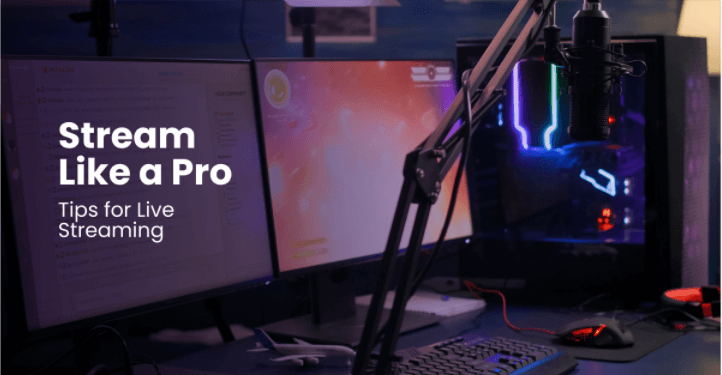Live streams are used by companies and content creators to engage audiences, monetize content, inform customers, and much more. When creating a livestream event, it’s important to understand best practices to achieve the greatest results possible. This guide with best live streaming tips uncovers the meaning of live streaming and shares five insightful tips to use during your next event.
What is Live Streaming?
While basic streaming can be pre-recorded, live streaming is the act of creating and sharing a live video on the internet in real-time.
People livestream webinars, news broadcasts, social media videos, sporting events, video game content, and more. Companies use live streaming to increase brand awareness, retain and engage viewers, build a wider audience, and monetize their websites.
Types of Live Streaming
Not all live streams are created equal. Understanding the different types helps tailor your strategy to fit your audience and content goals.
Event Streaming
Perfect for covering live occurrences like concerts, sports events, or conferences. It lets audiences feel like they’re part of the action, even from their couch.
- Concerts: Watch your favorite band’s performance live.
- Sports Events: Real-time game coverage with commentary.
- Conferences: Industry leaders sharing insights as they happen.
Personal Streaming
All about individual expression, where influencers and creators connect directly with their fans.
- Vlogs: Daily life streams that offer a personal touch.
- Social Media Lives: Instagram and TikTok streams that engage followers instantly.
Corporate Streaming
Businesses communicate with their audience for marketing, training, or internal communication.
- Webinars: Educational sessions on industry trends.
- Corporate Events: Company announcements or product launches.
Benefits of Live Streaming
Live streaming isn’t just about broadcasting; it’s about creating a dynamic connection with your audience.
Immediate Audience Engagement
Allows for real-time interaction. Viewers can comment, ask questions, and receive instant feedback, building a sense of community.
- Real-Time Q&A: Answer viewer questions as they watch.
- Live Polls: Engage your audience with interactive polls.
Global Reach
Your content isn’t limited by geography. Reach viewers across the globe without the cost and logistics of traditional broadcasting.
- International Audiences: Expand your reach to different countries and cultures.
- 24/7 Access: Offer content that can be accessed anytime, anywhere.
Increased Brand Exposure
Enhances your brand’s visibility. It’s an opportunity to showcase your expertise and build trust with your audience.
- Brand Loyalty: Create memorable experiences that keep viewers engaged.
- Visibility: Stand out in a crowded digital landscape.
How to Enhance Your Live Streams
Use the following tips to improve the effectiveness of your next livestream.
Pick the Right Platform
The two main types of livestream platforms are social media platforms and platforms that specialize in live streaming.
When deciding which to use, consider where your audience spends their time. If most of your audience interacts with you primarily through one social media platform, you can use it to host your live streams.
For example, travel bloggers may prefer Instagram, video gamers may prefer Twitch, and software professionals may prefer YouTube. YouTube Live, Facebook Live, Instagram Live, and Twitch are examples of social media platforms you can broadcast on.
If your audience uses multiple social media platforms or has less of a social media presence, it’s better to use a platform that specializes in live streams. Examples of these include Restream, Dacast, and Brightcove.
These platforms let you stream on websites and multiple social media platforms simultaneously. They also provide monetization tools, analytic reports, tech support, and more.
Market Your Livestream
Before you host your livestream, it’s important to build awareness for it. You can do this by creating excitement on your social media pages, sending informational emails to your list, and having viewers pre-register for your livestream.
Within your marketing material, make sure to include specific details on how to join the event, what time the event will begin and end, and what to expect during the livestream.
To create anticipation, you can include exclusive sneak peek videos, hint at potential discounts, and ask users to submit questions and ideas for the event. It’s also helpful to include reminder emails, push notifications, or texts leading up to the livestream.
Optimize Lighting and Audio
To create an exceptional livestream presentation, make sure your lighting and audio is optimized.
Lighting

First, ensure all presenters are wearing solid colors and simple fabrics. Colors that are too bright or shiny, and patterns that are too complex are less optimal for your camera.
You should also be careful if filming outdoors. The sun can often be too bright and make it difficult for your presenter to be seen. When in doubt, film inside a well-lit room.
Finally, avoid backlighting your presenter. If the dominant light source is coming from behind your presenter, it can display a silhouette of him or her. Instead, have your primary light source in front of the presenter to ensure the best lighting.
Audio
First, beware of adding music that you aren’t permitted to use. There are laws that require you to receive permission from the artist before playing their music for a public performance. When in doubt, leave out licensed music.
Second, always keep in mind when a mic is on. If someone accidentally says something irrelevant or inappropriate with a live mic, it can come off as unprofessional. Make sure everyone who is not presenting remains quiet throughout the streaming event.
Finally, use a lapel mic if you’ll be streaming on the go. A lapel mic easily attaches to your shirt, reducing the need to hold one up to your mouth. Lapel mics can also reduce background noise from cars and planes.
Do a Test Run before Going Live
It is critical to do a test run and practice before launching your livestream. Start by defining a clear goal for your livestream. Do you want to grow your audience, build a stronger relationship with your customers, or sell a product or service?
Once you have a clear goal for your stream, create an outline of key topics you aim to cover. Next, ensure everyone on your team is informed about the event and its timeline. Ensure your Wi-Fi is strong enough to support your stream, and you can run a speed test to measure your bandwidth.
Finally, test all equipment including microphones, cameras, and computers to ensure everything runs smoothly. You can also conduct recorded practice runs to make sure you’re ready for the live event.
Incorporate Engagement and Monetization Tools
Once you start your livestream, use tools that let your audience engage in real-time and that let you monetize your stream. The best ways to do this are through a live chat or a live blog.
Live Chat
A tool like Arena Live Chat lets livestream viewers interact with you and other viewers in real time. This can take the form of instant messaging, community polls, and Q&A segments. By increasing engagement through live chat, you ensure your audience is actively participating during your event and less likely to lose interest.
Live chat tools also let you monetize your livestream event. This can be used to collect tips for a helpful presentation, donate gifts relevant to your stream, or raise funds for a charity event. Arena Live Chat integrates with PayPal and will offer integration with Stripe in the near future to collect donations, gifts, and tips during events.
Live Blog
Live blogs are a way to share quick updates as a livestream event unfolds. A tool like Arena Live Blog lets companies and content creators send out quick, informative updates that keep users engaged during a livestream. A live blog can improve engagement during virtual business conferences, online news broadcasts, live sports streams, and more.
Live blogs can also monetize livestream events by collecting ad revenue. Arena Live Blog can be paired with DFP, Google AdSense, and other ad platforms to monetize your livestream. Integrating ad platforms is an easy process that lets users seamlessly add additional income streams to their event.
How Live Streaming Works
Understanding how live streaming works is crucial to delivering a seamless experience.
- Technical Setup: Cameras, microphones, and lighting are essential. High-quality equipment ensures your stream looks and sounds professional.
- Streaming Software: Choose platforms that suit your needs. OBS Studio, Streamlabs, and Arena’s tools offer various features for different requirements.
- Internet Connection: Stable and fast internet is non-negotiable. A reliable connection prevents disruptions and ensures smooth streaming.
How to Enhance Your Live Streams
Use these tips to improve the effectiveness of your next livestream.
Pick the Right Platform
The two main types of livestream platforms are social media platforms and platforms that specialize in live streaming. Consider where your audience spends their time when deciding which to use.
For example, travel bloggers may prefer Instagram, video gamers may prefer Twitch, and software professionals may prefer YouTube. Platforms like Restream, Dacast, and Brightcove let you stream on websites and multiple social media platforms simultaneously.
Market Your Livestream
Build awareness before hosting your livestream. Create excitement on social media, send informational emails, and have viewers pre-register. Include details on how to join, start and end times, and what to expect. Use sneak peek videos, hint at discounts, and ask users for questions and ideas.
Optimize Lighting and Audio
To create an exceptional livestream presentation, optimize lighting and audio.
Lighting
Ensure presenters wear solid colors and simple fabrics. Avoid filming outdoors if the sun is too bright. Film inside a well-lit room and avoid backlighting.
Audio
Beware of using music without permission. Keep non-presenters quiet. Use a lapel mic for on-the-go streaming to reduce background noise.
Do a Test Run before Going Live
Define a clear goal for your livestream. Create an outline of key topics and ensure your team knows the event timeline. Test Wi-Fi strength, microphones, cameras, and computers for smooth operation.
Incorporate Engagement and Monetization Tools
Use tools that let your audience engage in real-time and monetize your stream. Arena Live Chat lets viewers interact with instant messaging, polls, and Q&A segments. Arena Live Blog shares quick updates and monetizes through ad revenue.
Conclusion
We shared these tips to help you develop the best livestream event possible. By selecting the right platform, marketing your event, optimizing lighting and audio, conducting test runs, and adding engagement and monetization tools, you’ll be able to create a superior livestream experience.
If you want to learn more about enhancing your livestream events, download our free eBook by clicking the link below.



